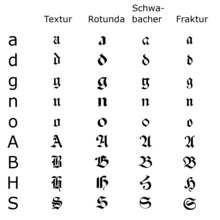Theuerdank (writing)
The Theuerdank even Theuerdank fracture called, is in the typography the oldest form of Gothic script . Its creation is closely linked to Emperor Maximilian I (HRR) as well as typists and printers from Nuremberg and Augsburg . Its earliest appearance in the printing press is dated to the year 1512. It was used for the first time to print the works of Maximilian I's prayer book and Theuerdank , from where it got its name.
Since the font originated in the Renaissance , it is also known as Renaissance Fraktur . It became the starting point for the further development of Gothic script. Its successor was the Breitkopf Fraktur in the Baroque around 1750 .
Emergence
After the invention of letterpress printing by Johannes Gutenberg , printers in the German-speaking world initially imitated the previously handwritten textura . The most famous example of this is the Gutenberg Bible . But soon they preferred to use the Schwabacher type; in other countries the Bastarda . At the same time, antiqua from Italy found its way into many countries and partly also in German-speaking countries . While at the beginning of the 16th century the printers had long since turned away from the Textura, Emperor Maximilian I (HRR) commissioned several high-quality printed works with artistic fonts specially made for them, which represented a continuation of the Textura. It was based on the handwriting used in his office (chancellery script). The first of these works was Maximilian's prayer book (printed 1512/1513), the second was Theuerdank (printed 1517). Both should give the impression of handwriting .
The secretary of Maximilian I. Vinzenz Rockner provided the handwritten templates for the printers' type for both the prayer book and the Theuerdank . The Augsburg book printer Johann Schönsperger d. Ä. became Maximilian I's secret printer in 1508. He cut the letters for both works according to Rockner's design. He printed the prayer book in Augsburg. For the first printing of Theuerdank he moved to Nuremberg at the request of the court. He printed the second edition again in Augsburg.
The prayer book had only a very small edition (10 copies on parchment were planned, 5 of which have survived) and its typesetting and printing were still incomplete. With the Theuerdank as well as other printed works, especially from Nuremberg and Augsburg, the font finally gained wide recognition and distribution.
Further development
The Nuremberg scribe Johann Neudörffer the Elder published a writing sample book in 1519 in which he introduced various text examples to the writing of Kurrent and Fraktur fonts. Neudörffer's neighbor was Albrecht Dürer . He included him in the Ehrenpforte work commissioned by Emperor Maximilian I : Dürer and other artists provided the templates for the individual images, Neudörffer the design of the font. The Nuremberg form cutter Hieronymus Andrae made pictures and writing in wood between 1522 and 1527. The Ehrenpforte shows for the first time a fracture cut in wood. Neudörffer also implemented Fraktur in its own type, in which Dürer had his theoretical works printed, which helped the font to make a breakthrough.
The Fraktur quickly prevailed against the Schwabacher script as the most widely used script in the 16th century. It became so popular in the German-speaking world that - unlike in France , Italy , Spain and England - the Antiqua did not establish itself as the commonly used script. This is how the German special route came about, the so-called script split : until the 19th century, texts in Latin and other languages or text passages were set in the Antiqua, and German texts in the Fraktur. For fracture and other broken fonts own typographic tradition that originated fracture rate . In its heyday, the Fraktur spread from the German-speaking area to the Scandinavian area. It was not until the antiqua-Fraktur dispute in the late 19th and early 20th centuries that the antiqua became the dominant font in the German-speaking world.
features
The Theuerdank Fraktur appears less coarse among the broken fonts than the Schwabacher, but at the same time less strict than the Textura. A typical feature of Theuerdank and the Fraktur in general is that the shafts of the letters are partly straight and partly rounded. Another typical feature are the S-shaped, trunk-like curlicues of the broad capitals , also called elephant trunks in printer language , which give the typeface the expression of a decorative font . This expression was reinforced in the Theuerdank print by adding curlicues to the typeface with the nib.
Type sets
The type sets of the prayer book and the Theuerdank contain a number of letters in more than one glyph variant , as well as various ligatures , punctuation marks and numbers .
Theuerdank fracture, cut in 1933 by the Monotype Corporation from the original from 1517
Individual evidence
- ^ Fritz Funke: Buchkunde: An overview of the history of the book . Walter de Gruyter & Co KG, 2012, ISBN 978-3-11-094929-2 , p. 223 ( books.google.de ).
- ^ Fritz Funke: Buchkunde: An overview of the history of the book . Walter de Gruyter & Co KG, 2012, ISBN 978-3-11-094929-2 , p. 223 ( books.google.de ).
- ↑ Dr. Olaf Schneider: The invention of the "fracture" - the typist and arithmetic master Johann Neudörffer the Elder . In: Uniforum (Giessen) . tape 28, 3 , 2015, pp. 14 .






